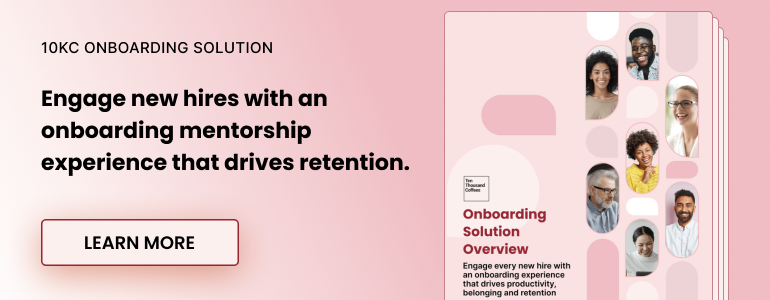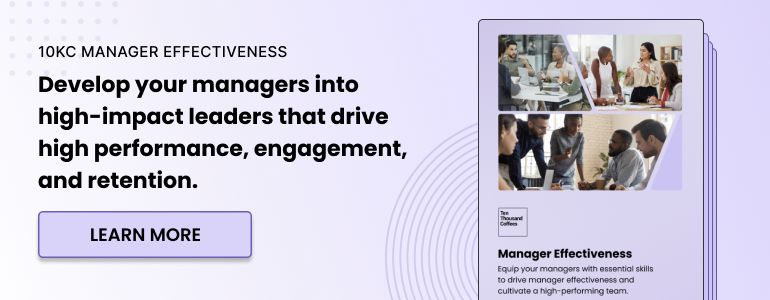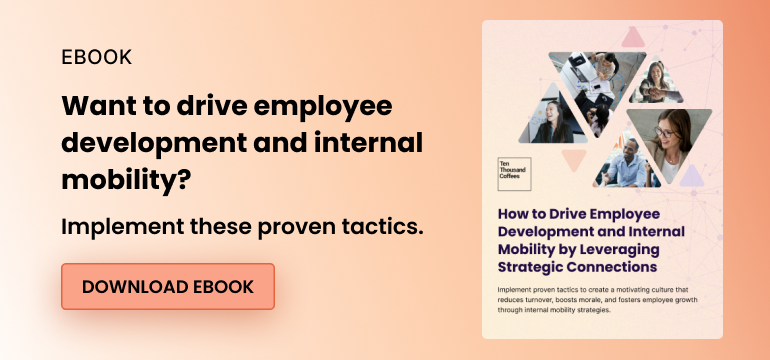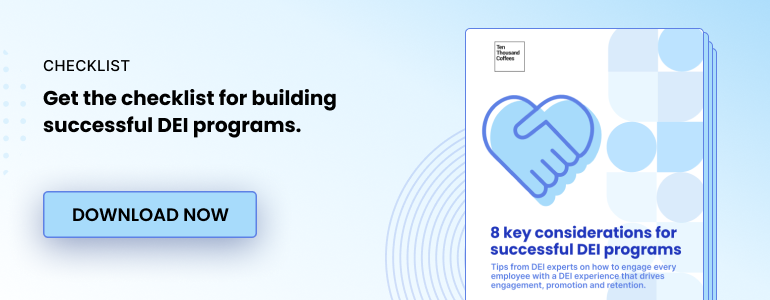Your employees are your biggest asset and the backbone of your business. The right people will help you build valuable products, offer the best services, and keep your customers happy. Losing them is costly and disruptive, and the last thing you want is to see them walk out the door. Unfortunately, employee turnover is a major problem plaguing businesses of all sizes.
If you want to stop the revolving door and keep your top talent, you've come to the right place.
In this article, we’re breaking down the basics around employee retention, why it matters, and the factors that cause employees to leave. Plus, we’ll leave you with actionable ways to boost employee retention that help you stand out from the crowd.
What is employee retention?
Employee retention is your organization’s ability to keep your employees. More specifically, it’s your ability to prevent employees from leaving your company, both voluntarily and involuntarily.
Poor employee retention significantly affects your business’s bottom line, which is why limiting turnover is critical to any successful enterprise.
While employee retention isn’t always easy to manage, it is easy to measure—making it possible to quickly spot downward trends and invest in the most effective strategies.
Calculating your employee retention rate is simple.
Take the number of employees you have at the start of a period of time, and divide it by the number of employees at the end of that same time period.

Let’s say you start the year with 100 employees. If 15 people leave throughout the year, you’ll have 85 employees at the end of the year, which means you have an 85% employee retention rate.
What is an employee retention strategy?
An employee retention strategy is the plan you put in place to keep employees at your company.
This might include initiatives or best practices that you follow in order to boost employee retention and reduce turnover.
Having an intentional employee retention strategy is a key part of ensuring that you’re doing everything you can to help your employees stick around longer.
“We talk about client retention and market share growth and the value creation you get there. But once again, you can't do it without the right people. [...] If you don't get this right early, you lose your best.” - Beth Simonetti, EVP, Chief Human Resources Officer, TD SYNNEX
The effects of poor employee retention
There’s a common trope that every employee is replaceable. In theory, there’s nothing stopping you from replacing an employee with another one. But that attitude ignores the devastating impact of high turnover.
High rates of employee turnover doesn't just create a staffing gap – it sends shockwaves through your entire business.
The effects of poor employee retention can include:
- Cost of replacing employees: While you certainly can rehire for a vacant role, hiring an employee is expensive. Depending on the type of role and that employee’s experience, on average it can cost anywhere from 0.5x to 2x an employee’s entire annual salary to replace them. When it comes to senior leaders, you could be looking at an even higher expense. If you’re replacing multiple employees every year, the costs can add up quickly.
- Loss of institutional knowledge: It takes time to build up internal knowledge of your systems, operations, and business goals. When employees leave, they take this information with them. A new employee may eventually start to pick up those details, but it can take months or even years to get to the same level of institutional knowledge.
- Low employee morale: When employees constantly see people around them leaving the workplace—even if they’re otherwise satisfied with their work experience—it can quickly impact their morale at work. Low employee morale is closely tied to a decrease in employee productivity and low employee engagement. Both of which can exacerbate any employee retention challenges you’re already facing.
- Damage to employer brand: Employees talk. If it becomes clear that turnover is high in your company, it can raise red flags for potential candidates. It’s a sign that employees don’t love working at your company and it can deter employees from signing a job offer or even applying for open roles.
Importance of employee retention in 2024
Employee retention isn’t a modern concept. However, in the new world of work—one that blends in-office, remote, and hybrid work arrangements with globally dispersed workforces— keeping top talent is becoming a bigger challenge for employers. Lifelong employer loyalty is a thing of the past and job hopping has become the norm, particularly among the younger generations.
The way we work might be changing, but that’s not to say that employers can’t—and shouldn’t—curb these trends. Here’s what we know about employee retention in 2024:
- Retention is a top priority for businesses. 60% of CEOs say that retaining and engaging employees is a top priority.
- Employees are ready to switch jobs. Nearly three quarters of employees (71%), in Canada alone, are thinking of leaving their current jobs.
- Leaders are expecting retention to be a challenge. 33% of U.S. managers expect turnover to increase in 2024.
While it looks like employers are gearing up for a potentially big year of employee turnover, there’s one more thing that we know: it’s still possible for employers to turn the tide on employee retention.
However, to do that, it’s important to understand the driving forces behind employee retention.
What impacts employee retention?
Let’s face it. With the odd exception, employees don’t just suddenly decide to change employers one day—especially if they’re happy with their job. Employee retention is the outcome of a bunch of other organizational challenges. Which means you can’t tackle employee retention head on. Rather, you need to look at the things that encourage employees to stay and the things that drive them away.
Why do employees stay?
There are employees who actively choose to stick with their employer, even when other career opportunities come their way. Some of the biggest reasons someone might choose to stay with their current employer include:
- Paths for advancement: The overwhelming majority (90%) of employees say that a clear career path is a priority in their job.
- Opportunities for mentorship: Retention rates are higher for those who participate in a mentorship program (72% for mentees and 69% for mentors) than for employees who aren’t a mentor/mentee (49%).
- Community and connection: Feeling connected with colleagues, managers, and leadership across the organizations combats isolation, fosters a shared purpose, and ensures a sense of belonging. This all contributes to a significantly lower chance of employees seeking opportunities elsewhere.
- Feeling appreciated in their roles: Whether it’s an acknowledgment of their effort or adequate compensation, when employees feel fairly appreciated, they’re more likely to stay at an organization.
- Work that aligns with their goals: When employees feel fulfilled in their role, they’re more likely to be happy with their current job.
“In every aspect of the way we live our lives as human beings, we want to belong. And the easier we make it for individuals to feel themselves as part of something, the more likely it is for those people to stay, to grow and develop in that environment. [...] So reducing those barriers to belonging is so key. And the way you create belonging is through relationship.” - David Simmonds, SVP, Global Chief Communications and Sustainability Officer, Canada Life
Why do employees leave?
The reasons employees leave a company can be highly personal. Some of the common reasons that employees leave their jobs can include:
- Lack of belonging: When employees feel like they’re in a silo—both in their work and as a person —they are unlikely to feel connected to your company and are more likely to leave.
- Lack of learning and advancement opportunities: 41% of employees say that lack of career development and advancement opportunities is the reason they left their previous employer.
- Change of career paths: Employees may choose to leave their jobs to take on a different career path or work in a different industry.
- Economic and market landscape: In a candidate’s market, where salary offers are high and there are many opportunities available, employees are more likely to explore alternative employment options.
8 employee retention strategies for 2024
There are a lot of factors that impact employee retention. And if we’re being honest, not all of them are in your hands—but many of them also are.
Here are some powerful employee retention strategies you can implement to keep your best talent around longer:
1. Implement employee mentorship, connectivity, and networking programs
Don't assume employees will build their own networks, connect across teams, or find mentors organically. We know that leaving networking up to chance can be inequitable and impacts employees’ ability to get ahead—particularly those from underrepresented backgrounds. Plus, in remote or hybrid work environments, connecting with colleagues or leadership organically is a major challenge.
Instead, proactively create opportunities for connection and mentorship through structured initiatives.
Remember, this is about more than just furthering employee career development. In many cases, mentorship programs have been able to significantly decrease rates of employee turnover. Spring Health invested in a mentoring program that reduced rates of employee attrition from 32% to 15%
CASE STUDY: How 10KC Helped Spring Health Scale Mentorship and Decrease Attrition of Diverse Talent by Over 50%
Mentoring and connectivity programs offer employees career growth, a sense of belonging, and greater visibility within the organization. These benefits directly translate to increased satisfaction and loyalty, boosting retention.
Remember: mentorship doesn’t have to be limited to traditional 1-1 relationships. Many types of mentoring, such as peer-to-peer mentoring, group networking opportunities, cross-departmental connections, and even reverse mentorship can also help promote better engagement and retention within your organization.

2. Provide a comprehensive onboarding program
Employee retention starts from day one. No employee starts their first day on the job expecting to leave—but first impressions matter. If they get thrown into the fire immediately or aren’t set up for success, those feelings of wanting to leave can creep up quickly.
A strong onboarding process can increase employee retention by as much as 88%. Onboarding helps new employees acclimate to their new roles. It gives them an opportunity to learn about the company, get used to the new systems in place, and of course, meet the people they’ll be working with.
Companies also tend to underestimate the value of social onboarding. Connecting new employees with a network of peers is one of the best ways to help them feel welcome and valued. When a new employee is paired with an onboarding buddy for the first 90 days, job satisfaction increases by 36%.

3. Invest in leadership development
Like many business challenges, your leadership can significantly impact employee retention.
When it comes to employee retention, investing in leadership is two-fold.
If you have a team of strong leaders, they can motivate and engage your employees. They are also able to earn the trust of employees to help them better support them through times of change and uncertainty.
Leadership development also creates opportunities to develop a pipeline of future leaders. It carves our career paths for top performers and gives them opportunities to step into future leadership roles. When employees feel that you’re invested in their future, they’re more likely to be satisfied with you as an employer.

4. Create a culture of employee learning and development
Learning and development might just be one of the most underutilized tools for employee retention. Many of us assume giving more responsibility to employees who are one foot out the door is counterproductive, but it’s not. Ultimately, not giving these employees opportunities to advance in their careers might be the reason that they leave.
60% of people said they are expecting to get a promotion in 2024, and 50% of them will look for a new job if they do not receive this expected promotion. And employees who get professional development opportunities are 15% more engaged and have 34% higher retention than those who don’t.
However, it’s not just about giving out random promotions and learning opportunities. The companies that manage to provide career development opportunities equitably and effectively, tend to have a systemized process in place, such as early career programs or DEI development programs.
And of course, employees that have a habit of learning are also more adaptable. This makes your entire workforce more agile and makes it easier to flex as your business and the economic landscape inevitably shift. This will make your employees more resilient through times of change, all while potentially reducing the need for costly involuntary turnover.

5. Make DEI a priority
The importance of diversity, equity, and inclusion (DEI) in workplace culture is something that we hear time and time again, and for good reason. When DEI is a core part of how you work, it creates a welcoming and inclusive workplace for employees of all backgrounds. This creates a more positive work environment where employees are not only more productive, but happier.
However, DEI isn’t just about retaining your existing employees. 32% of employees wouldn’t even consider a job at a company where there’s a lack of diversity among its workforce. Without a DEI strategy in place, it can be challenging to fill new or vacant roles.
Popular DEI initiatives include employee resource groups (ERGs) and diversity mentorship and sponsorship programs. Consider also conducting a DEI audit to ensure that things like your benefits policy or code of conduct are inclusive to all populations within the workplace.

6. Give employees a purpose
Employees want to make an impact—both on their own lives and the world around them. And given they spend a large portion of their week at work, it tracks that they want to have a sense of purpose in the work they do.
What work is meaningful to every employee will be different. Are they working toward a larger company mission? Are they making an impact on the community? Are they making strides toward their own professional development?
Helping employees identify their purpose and ensuring that they feel fulfilled is key to keeping them around longer.
7. Offer competitive compensation and benefits
We can’t ignore the fact that employees work to earn a living. They need to feel fairly compensated for the work that they’re doing. If they don’t feel like they’re being paid fairly for the work they do, they’re likely going to look elsewhere.
Remember, compensation isn’t just about salaries. The entire compensation package needs to address their needs. This includes everything from paid time off and benefits to career development opportunities.
So, while one way to attract and retain employees is by paying top dollar, it’s not the only strategy. In fact, it’s almost impossible to buy your way to employee retention without many of the other strategies on this list.
8. Make flexibility a pillar of your business
The pandemic taught us a vital lesson: flexibility is essential for employee satisfaction.
Remote work is one form of flexibility, but not always feasible for every business. That's why it's crucial to find other ways to offer employees autonomy and control over their work lives.
Options like flexible hours or some choice over projects can be incredibly valuable for retention. In fact, 78% of workers prioritize schedule flexibility over location flexibility.
Even when facing challenges like a return-to-office plan, demonstrating flexibility wherever possible shows employees you value their needs. This proactive approach can go a long way in keeping your top talent.
Boost your employee retention with 10KC
Employee turnover is a growing concern across industries, making finding effective retention strategies more urgent than ever. You don't have to tackle this challenge alone.
10KC is the only all-in-one corporate mentoring and networking platform designed to help companies boost employee engagement, development, and retention. By partnering with 10KC, you can:
- Foster connection: Our Smart-Match algorithm removes bias by connecting employees based on shared interests and goals, ensuring everyone gets the chance to build relationships and grow.
- Expand employee networks: Connect employees with their peers by leveraging a mix of 1:1 and group sessions that expand networks and boost employee visibility.
- Promote learning and development: Turn mentorship into actionable growth with structured development and curriculums tailored to your company's objectives and employees' needs.
- Measure the impact of your employee retention strategies: Stay on top of employee retention with comprehensive data dashboards and insights on employee sentiment.
.png)









.png)